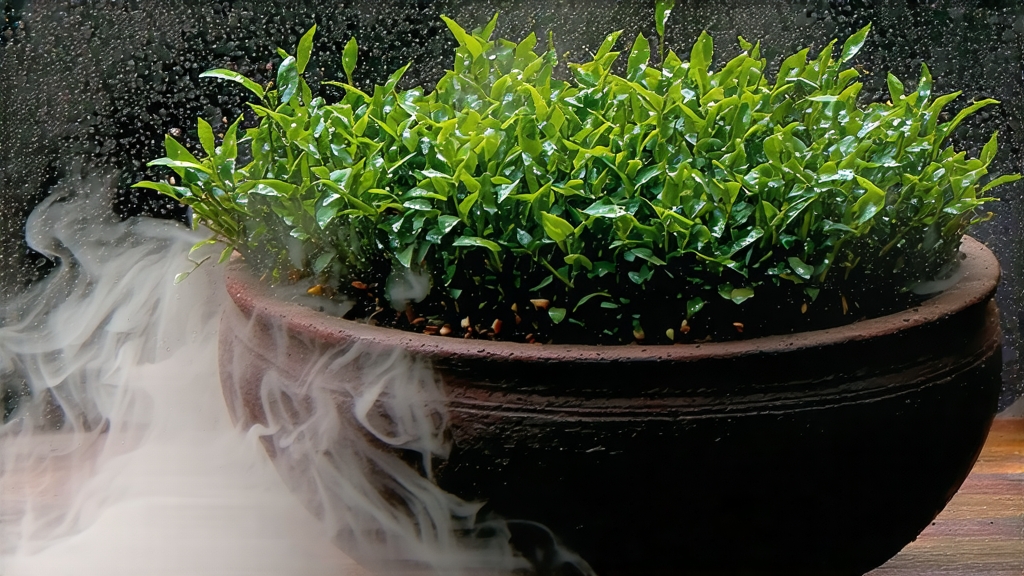
Tucked away in the humid, karst-pitted mountains of southern China’s Guangxi Zhuang Autonomous Region, Liu Bao tea has spent four centuries quietly fermenting its way into the hearts of Cantonese merchants, Southeast Asian dockworkers and, more recently, global dark-tea aficionados. While Pu-erh grabs headlines, Liu Bao remains the sleeper hit of the Hei Cha (dark tea) family: a leaf that tastes of damp earth, cacao and a whisper of tropical betel, yet finishes with a cool, mint-like throat that refuses to let go. To understand Liu Bao is to watch history steep in a cup—each infusion releasing decades of caravan trails, river-boat humidity and bamboo-basket microbiology.
Historical footprints
The name “Liu Bao” literally means “Six Forts,” a reference to the six defensive outposts that once guarded the small trading township of Cangwu County, Wuzhou. During the Qing dynasty, the Pearl River’s upper tributaries carried tightly packed baskets of this dark, partially fermented tea down to Guangzhou’s Thirteen Factories and onward to British, Dutch and Malay entrepôts. Laborers in colonial Malaya swore by its ability to “cut the grease” of coconut-rich curries and to ward off damp-induced rheumatism; Chinese coolies in Singapore’s rubber plantations traded their morning kopi for a tin of Liu Bao boiled in condensed-milk cans. By the 1950s, state-run Guangxi Tea Import & Export was exporting over 3 000 tons annually to Hong Kong, Malaysia and Indonesia, where the tea was often stacked in godowns next to sacks of white pepper, absorbing spice-laden air that still perfumes vintage cakes today.
Micro-terroirs within one county
Purists divide Liu Bao into three micro-zones, each defined by elevation, soil chemistry and the strain of indigenous Camellia sinensis var. sinensis.
- Gao Chong (High Ridge): 600–800 m basalt soils, mist-shrouded 200 days a year. Leaves here are naturally low in bitterness, yielding a liquor that recalls black-forest soil and cacao nibs.
- Da Shan (Big Mountain): granite-derived sandy loam at 400–600 m. Stronger diurnal temperature swings build more polyphenols, giving a punchier, betel-nut forward profile prized by Hong Kong tea masters.
- He Kou (River Mouth): alluvial flats at 100–300 m where warm air traps humidity. The leaf is broader, fleshier, and ferments faster—ideal for the mass-market “worker’s brick” still sold in wet markets across Guangdong.
Crafting the darkness
Unlike Pu-erh’s regionally protected sun-drying, Liu Bao undergoes a Guangxi-specific “wet piling” (wo dui) that predates the 1973 invention of ripe Pu-erh by at least three centuries. Fresh leaves are pan-fired at 280 °C for three minutes to kill green enzymes, then rolled on bamboo trays to rupture cell walls. The twist comes overnight: semi-oxidized leaves are piled 70 cm deep inside steamed bamboo baskets lined with guava leaves. Tea artisans—almost always women—sprinkle river water drawn from the Xun Jiang, whose microflora (Bacillus subtilis, Aspergillus niger, Blastobotrys adeninivorans) inoculates the pile. Every hour the pile is flipped with long teak rakes; temperature probes must stay between 55–60 °C. After 18–24 h the leaf turns chestnut-brown and exudes a sweet, almost soy-sauce aroma. The tea is then sun-dried on rattan mats for half a day, steamed again, and pressed into 40 kg bamboo baskets called lang. These lang are moved to humid caves or specially built “fermentation warehouses” where relative humidity hovers at 85 % for a minimum of twelve months. Some lots sleep for thirty years, developing the coveted chen xiang (aged scent) that auction houses compare to antique sandalwood.
From basket to brick: modern shapes
While traditional basket tea is still shipped intact to Kuala Lumpur, most Liu Bao now reaches consumers in three convenient forms:
– 250 g “pineapple” brick (boluo zhuan): convex sides mimic the fruit, designed for altar offerings during the Hungry Ghost Festival.
– 5 g “dragon pearl” mini-tuo: flash-steamed and marble-rolled for single-serve gongfu sessions in downtown cafés.